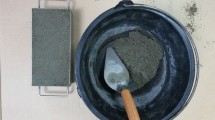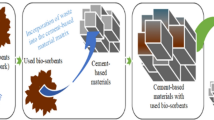Abstract
The utilization of construction and demolition waste materials for the radionuclide immobilization by sorption processes was investigated. Given that the liquid radioactive waste usually has a complex composition and that effects of competition may significantly influence the efficiency of the treatment, the Simplex Centroid experimental design was used to explore ions sorption from multi-component solutions. For the purpose of this study, the common components of construction and demolition waste, such as pathway concrete and different bricks samples, were used along with the multi-component Sr2+, Co2+, and Ni2+ ions solutions. The equations for the prediction of metal ions sorption capacities were derived. The coefficients that correspond to the linear and interaction terms were obtained using a special cubic model. Likewise, by analysis of variance, statistically significant terms of the obtained polynomial were defined. The investigation has shown that the most effective sorption was onto the pathway concrete for all three cations, while the highest sorption capacity was found for Co2+ ions. Also, it has been determined that concerning Sr2+ ion removal there was a competition with coexisting Co2+ and Ni2+ ions, reducing its sorption capacity, while sorption of Co2+ and Ni2+ occurred more independently on other cations in multi-component solutions. Based on the obtained results, the applied experimental design can be efficiently used for the description of competitive sorption process and could be a powerful tool for the prediction of cation immobilization in liquid radioactive waste treatment.


Similar content being viewed by others
References
Bennert, T., Papp, W. J., Maher, A., & Gucunski, N. (2000). Utilization of construction and demolition debris under traffic-type loading in base. Journal of the Transportation Research Board, 1714(1), 33–39.
Bianchini, G., Marrocchino, E., Tassinari, R., & Vaccaro, C. (2005). Recycling of construction and demolition waste materials: a chemical-mineralogical appraisal. Waste Management, 25(2), 149–159 149–159.
Black, L., Garbev, K., & Gee, I. (2008). Surface carbonation of synthetic C-S-H samples: a comparison between fresh and aged C-S-H using X-ray photoelectron spectroscopy. Cement and Concrete Research, 38, 745–750.
Brown, G., & Parks, G. (2001). Sorption of trace elements on mineral surfaces: modern perspectives from spectroscopic studies, and comments on sorption in the marine environment. International Geology Review, 43(11), 963–1073.
Consoli, N. C., Cruz, R. C., Floss, M. F., & Festugato, L. (2009). Parameters controlling tensile and compressive strength of artificially cemented sand. Journal of Geotechnical and Geoenvironmental Engineering, 136(5), 759–763.
Cui, H., Tang, W., Liu, W., Dong, Z., & Xing, F. (2015). Experimental study on effects of CO2 concentrations on concrete carbonation and diffusion mechanisms. Construction and Building Materials, 93, 522–527.
El-Gohary, M. A., & Al-Naddaf, M. M. (2009). Characterization of bricks used in the external casing of Roman bath walls “Gadara-Jordan”. Mediterranean Archaeology and Archaeometry, 9, 29–46.
EU Commission. (2014). Towards a circular economy: a zero waste program for Europe. COM(2014) 398 final. http://ec.europa.eu/environment/circular-economy/pdf/circular-economy-communication.pdf. Accessed 26 May 2019.
Fan, Y., & Luan, H. (2013). Pore structure in concrete exposed to acid deposit. Construction and Building Materials, 49, 407–416.
Grace, M. A., Clifford, E., & Healy, M. G. (2016). The potential for the use of waste products from a variety of sectors in water treatment processes. Journal of Cleaner Production, 137, 788–802.
Haratake, M., Hatanaka, E., Fuchigami, T., Akashi, M., & Nakayama, M. (2012). A Strontium-90 Sequestrant for first-aid treatment of radiation emergency. Chemical and Pharmaceutical Bulletin, 60(10), 1258–1263.
Hossain, K., Rashid, M. A., & Karim, R. (2015). Effect of cement content and size of coarse aggregate on the strength of brick aggregate concrete. Dhaka University of Engineering & Technology, 2(2), 20–24.
International Atomic Energy Agency. (1998). Radiological characterization of shut down nuclear reactors for decommissioning purposes. https://www-pub.iaea.org/MTCD/publications/PDF/TRS389_scr.pdf. Accessed 25 May 2019.
Jelic, I., Sljivic-Ivanovic, M., Dimovic, S., Antonijevic, D., Jovic, M., Mirkovic, M., & Smiciklas, I. (2017). The applicability of construction and demolition waste components for radionuclide sorption. Journal of Cleaner Production, 171, 322–332.
Jelic, I., Sljivic-Ivanovic, M., Dimovic, S., Antonijevic, D., Jovic, M., Serovic, R., & Smiciklas, I. (2016). Utilization of waste ceramics and roof tiles for radionuclide sorption. Process Safety and Environment Protection, 105, 348–360.
Kampa, M., & Castanas, E. (2008). Human health effects of air pollution. Environmental Pollution, 151, 362–367.
Khan, S., Cao, Q., Zheng, Y. M., Huang, Y. Z., & Zhu, Y. G. (2008). Health risks of heavy metals in contaminated soils and food crops irrigated with wastewater in Beijing, China. Environmental Pollution, 152, 686–692.
Lazić, Ž. (2005). Design of experiments in chemical engineering. Weinheim: Wiley-VCH Verlag GmbH &Co.
Lovrić, M. (2008). Basics of statistics. (in Serbian). Kragujevac: Faculty of Economics press.
Montaña, M., Camacho, A., Devesa, R., Vallés, I., Céspedes, R., Serrano, I., Blàzquez, S., & Barjola, V. (2013). The presence of radionuclides in wastewater treatment plants in Spain and their effect on human health. Journal of Cleaner Production, 60, 77–82.
Mymrin, V. A., Alekseev, K. P., Catai, R. E., Izzo, R. L. S., Rose, J. L., Nagalli, A., & Romano, C. A. (2015). Construction material from construction and demolition debris and lime production wastes. Construction and Building Materials, 79, 207–213.
Šljivić-Ivanović, M., Smičiklas, I., Dimović, S., Jović, M., & Dojčinović, B. (2015). Study of simultaneous radionuclide sorption by mixture design methodology. Industrial and Engineering Chemistry Research, 54(44), 11212–11221.
Sljivic-Ivanovic, M., Jelic, I., Dimovic, S., Antonijevic, D., Jovic, M., Mrakovic, A., & Smiciklas, I. (2018). Exploring innovative solutions for aged concrete utilization: treatment of liquid radioactive waste. Clean Technologies and Environmental Policy, 20(6), 1343–1354.
Sljivic-Ivanovic, M., Jelic, I., Loncar, A., Nikezic, D., Dimovic, S., & Loncar, B. (2017). The application of experimental design methodology for the investigation of liquid radioactive waste treatment. Nuclear Technology & Radiation Protection, 32(3), 281–287.
Trindade, M. J., Dias, M. I., Coroado, J., & Rocha, F. (2009). Mineralogical transformations of calcareous rich clays with firing: a comparative study between calcite and dolomite rich clays from Algarve, Portugal. Applied Clay Science, 42(3–4), 345–355.
Wu, G., Kang, H., Zhang, X., Shaob, H., Chu, L., & Ruan, C. (2010). A critical review on the bio-removal of hazardous heavy metals from contaminated soils: Issues, progress, eco-environmental concerns and opportunities. Journal of Hazardous Materials, 174, 1–8.
Yi, Y., Yang, Z., & Zhang, S. (2011). Ecological risk assessment of heavy metals in sediment and human health risk assessment of heavy metals in fishes in the middle and lower reaches of the Yangtze River basin. Environmental Pollution, 159, 2575–2585.
Zimbili, O., Salim, W., & Ndambuki, M. (2014). A review on the usage of ceramic wastes in concrete production. International Journal of Civil, Architectural, Structural and Construction Engineering, 8(1), 91–95.
Funding
This work was supported by the Ministry of Education, Science and Technological Development of the Republic of Serbia (Projects III 43009 and TR-34023).
Author information
Authors and Affiliations
Corresponding author
Additional information
Publisher’s Note
Springer Nature remains neutral with regard to jurisdictional claims in published maps and institutional affiliations.
Rights and permissions
About this article
Cite this article
Jelić, I., Šljivić-Ivanović, M., Dimović, S. et al. Radionuclide Immobilization by Sorption onto Waste Concrete and Bricks—Experimental Design Methodology. Water Air Soil Pollut 230, 242 (2019). https://doi.org/10.1007/s11270-019-4298-3
Received:
Accepted:
Published:
DOI: https://doi.org/10.1007/s11270-019-4298-3




